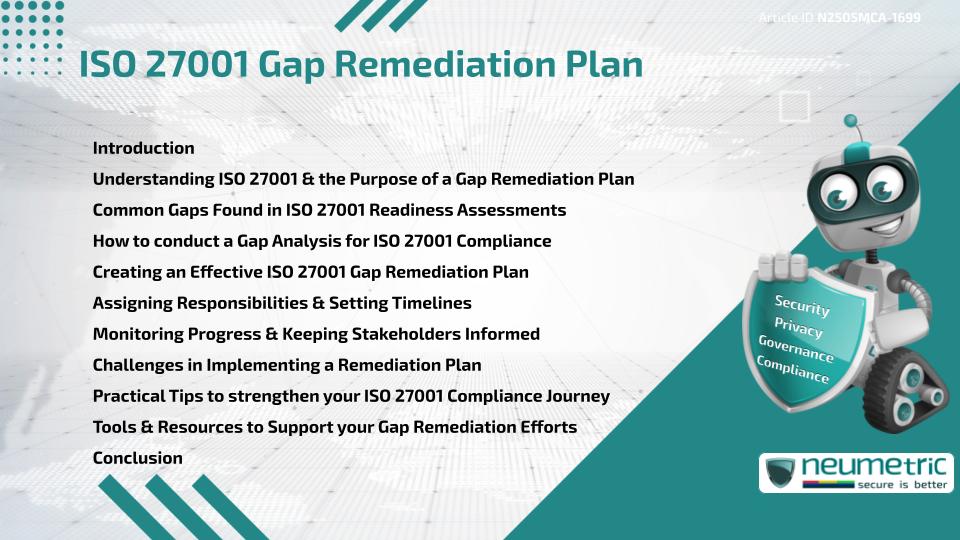Table of Contents
ToggleIntroduction
Achieving Compliance with ISO 27001, the global Standard for Information Security Management System [ISMS], requires more than just awareness of Best Practices. Organisations often discover significant Gaps when aligning their current Security Controls with ISO 27001 Standards. An ISO 27001 gap remediation plan is the structured Roadmap used to address these gaps efficiently & effectively.
In this article, we explore what the Plan involves, how to build it, the common pitfalls to avoid & why it’s essential for maintaining trust in today’s Threat-heavy digital environment.
Understanding ISO 27001 & the Purpose of a Gap Remediation Plan
ISO 27001 defines a structured approach to securing Sensitive Information. It involves setting up a robust ISMS & continuously improving it. A gap remediation plan helps businesses close the distance between where they are & where they need to be to comply with the Standard.
Think of the ISO 27001 gap remediation plan as a navigation tool—it doesn’t just point out problems, it offers a clear route to solutions. Without it, Organisations Risk Compliance failures & potential data breaches.
For an overview of the Standard, visit the ISO official website.
Common Gaps Found in ISO 27001 Readiness Assessments
Before a remediation plan can be written, a Gap Analysis or readiness assessment is conducted. This often reveals issues like:
- Missing documentation for Security Policies
- Lack of Risk Assessment or outdated results
- No defined Incident Response Plan
- Weak Access Controls or User Account management
- Absence of internal audits or regular reviews
Identifying these gaps is just the start. The real work begins with organizing these findings into actionable tasks.
Refer to this NIST guide to Risk Assessments for insights on evaluating Risk gaps.
Gap Analysis for ISO 27001 Compliance: Methodology
A Gap Analysis compares existing practices against ISO 27001 requirements. The process typically includes:
- Document review – Examine current Policies, processes & controls
- Interviews – Speak to key Stakeholders to understand existing practices
- Control mapping – Map current controls against Annex A of ISO 27001
- Reporting – Highlight Non-Conformities, partial implementations or missing items
This step lays the groundwork for your ISO 27001 gap remediation plan, making it targeted rather than generic.
Creating an Effective ISO 27001 Gap Remediation Plan
Once gaps are identified, the remediation plan can be drafted. It typically includes:
- Clear description of each gap
- Root cause analysis
- Remediation actions
- Priority level (high, medium, low)
- Responsible party
- Expected completion date
Avoid overly complex language. Simplicity & clarity keep the team aligned. The plan should be reviewed & approved by leadership to ensure organizational commitment.
Here’s a practical example: If access logs are not being retained, the plan should identify the system affected, propose a logging solution & assign a team to deploy it.
A well-written ISO 27001 gap remediation plan acts like a task list with strategic backing.
Assigning Responsibilities & Setting Timelines
Delegation is key. Each gap should be assigned to a responsible person or team. Use project management tools to:
- Set milestones
- Track progress
- Notify Stakeholders of updates or delays
Avoid vague assignments like “IT to resolve.” Instead, specify: “Security Officer to implement Audit logging on server ABC by this date.”
Setting achievable timelines is just as critical. Over-promising on delivery dates can lead to rushed or incomplete remediation.
You can explore this ISO implementation project timeline guide for reference.
Monitoring Progress & Keeping Stakeholders Informed
A plan is only as effective as its follow-through. Organisations should:
- Conduct weekly or bi-weekly reviews
- Measure closure rates
- Document completed & ongoing tasks
Engaging Stakeholders—including Compliance teams, IT & legal—helps keep everyone informed & invested. Dashboards & status reports are helpful in visualizing progress.
This promotes accountability & ensures gaps are not forgotten once the plan is created.
Challenges in Implementing a Remediation Plan
Despite careful planning, Organisations often face issues such as:
- Resource constraints – Limited staff or budget
- Resistance to change – Employees may see new controls as a burden
- Lack of technical understanding – Some remediation items may need specialist support
- Overlapping priorities – Security improvements may compete with operational goals
Being aware of these challenges allows you to plan for them—either by outsourcing, training or realigning priorities.
Practical Tips to strengthen your ISO 27001 Compliance Journey
- Start with quick wins – Resolve low-effort, high-impact gaps early
- Document everything – Evidence of action is key for audits
- Use version control – Keep a history of updates to Policies & plans
- Engage Top Management – Their support influences company-wide adoption
- Automate where possible – Use tools to monitor access, log events & track incidents
Each resolved item in the ISO 27001 gap remediation plan brings your Organisation closer to a secure & compliant environment.
Tools & Resources to Support your Gap Remediation Efforts
Some useful tools to support your remediation efforts include:
- Policy management systems
- Risk Assessment platforms
- Task tracking tools (like Trello or Jira)
- Document control & Audit readiness software
- Templates from Certification Bodies
These not only help with Organisation but ensure that your ISO 27001 gap remediation plan remains active, visible & results-driven.
Conclusion
An effective ISO 27001 gap remediation plan is the bridge between Compliance goals & operational reality. It enables Organisations to address weaknesses in their current Information Security Management System [ISMS] by laying out a structured path to meet ISO 27001 requirements. This plan is not just a checklist but a dynamic tool for aligning people, processes & technology with recognized Best Practices.
Throughout the implementation journey, it’s essential to prioritise identified gaps, allocate appropriate resources & involve Stakeholders at every stage. However, Organisations should also acknowledge the limitations—such as budget constraints or legacy systems—that may slow progress. Transparency & ongoing evaluation remain crucial for overcoming these challenges.
In essence, a well-executed ISO 27001 gap remediation plan helps transform an Organisation’s security posture from reactive to proactive. It ensures not only Compliance but also long-term resilience in the face of ever-evolving Cybersecurity Threats.
Takeaways
- An ISO 27001 gap remediation plan transforms Audit Findings into actionable improvements
- Success relies on clarity, accountability & steady follow-up
- Common obstacles include resistance, lack of resources & unclear roles
- Using the right tools & keeping all teams aligned increases your chance of success
FAQ
What is an ISO 27001 gap remediation plan?
It is a structured document that outlines how to address security & Compliance gaps identified during a Gap Analysis or readiness assessment.
How is a gap remediation plan different from a Gap Analysis?
A Gap Analysis identifies what’s missing, while a gap remediation plan lays out the steps to fix those issues, including timelines & responsibilities.
Who should be responsible for managing the ISO 27001 gap remediation plan?
Typically, the Information Security Manager or Compliance Lead manages it, coordinating efforts across IT, HR & leadership teams.
How long does it take to complete a remediation plan?
It depends on the complexity of the gaps, but most plans take between three (3) and six (6) months to complete fully.
Do we need a remediation plan if we’re outsourcing ISO 27001 Compliance?
Yes. Even with external help, your Organisation must document how gaps are resolved internally to meet Audit requirements.
Can we use templates for an ISO 27001 gap remediation plan?
Yes. Many Organisations start with templates but should tailor them to reflect their specific environment & Risk profile.
Is the remediation plan reviewed during an ISO 27001 Audit?
Yes. Auditors will review the plan to verify that identified gaps have been addressed with documented evidence.
What happens if a remediation plan is not followed?
Failure to follow the plan can result in failed audits, security Risks or non-Compliance with ISO 27001.
References
- ISO.org: ISO/IEC 27001 Information Security
- NIST SP 800-30 Rev.1 Risk Assessment Guide
- Advisera ISO 27001 Implementation Checklist
Need help?
Neumetric provides organisations the necessary help to achieve their Cybersecurity, Compliance, Governance, Privacy, Certifications & Pentesting goals.
Organisations & Businesses, specifically those which provide SaaS & AI Solutions, usually need a Cybersecurity Partner for meeting & maintaining the ongoing Security & Privacy needs & requirements of their Clients & Customers.
SOC 2, ISO 27001, ISO 42001, NIST, HIPAA, HECVAT, EU GDPR are some of the Frameworks that are served by Fusion – a centralised, automated, AI-enabled SaaS Solution created & managed by Neumetric.
Reach out to us!


